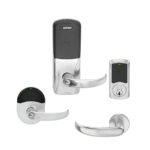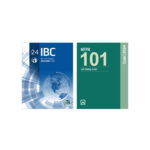This month’s question is a common one related to egress doors in memory care units. If you have a code question you’d like to see answered in my column, you can submit it by visiting iDigHardware.com/decoded-qa.
This post will be published in Doors & Hardware

Back in the 2009 editions of the model codes, changes were made that permitted doors in some health care units to be locked, restricting egress. The delayed egress locks that were commonly used prior to this code change created challenges for some facilities, where residents would often trigger the audible alarm and could potentially exit unaccompanied after the 15-second delay had elapsed. Today’s question is a common one related to memory care applications:
Is instructional signage and an audible alarm required for controlled egress installations in a health care facility?
First, it’s important to remember that controlled locks are only allowed by code in health care units where patients require containment for safety or security. These locks are not permitted by the model codes in other occupancy types, or on doors serving other areas in a medical facility. The model codes do not specifically address the types of units where this application may be installed, but controlled egress locks are commonly used on memory care units, maternity, nursery, and pediatric areas, behavioral health treatment facilities, and in some cases, emergency departments. The Authority Having Jurisdiction (AHJ) is responsible for approving the locations where the locks may be installed.
Although doors that are required for egress and additional doors that are provided for egress purposes must typically allow a building occupant to exit freely, controlled egress locks are an exception. They are addressed in the codes as one of the special locking arrangements, and all of the criteria listed in the adopted code(s) must be met. The requirements of NFPA 101 – Life Safety Code differ slightly from those of the International Building Code (IBC) and the International Fire Code (IFC).
In locations where controlled egress locks are permitted, the model codes prescribe the required release methods to allow building occupants to exit in an emergency. These typically include fail safe locks which release upon power failure, the capability of remote release from one or more prescribed locations within the building, and immediate egress upon fire alarm activation. Both sets of model codes allow some of the automatic release methods to be omitted on doors serving areas where specialized security measures are needed, including behavioral health units and maternity areas where listed child abduction systems are in use. The model codes also require all clinical staff to have the ability to release the locks, in case evacuation is necessary. Staff members must carry the keys, codes, or other credentials to unlock the doors, and these procedures must be documented in the facility’s emergency plan.
The model codes also include requirements related to the fire protection and detection system in the facility and emergency lighting near the doors where controlled egress locks are installed. Some codes limit the number of controlled egress locks that an occupant must pass through within a means of egress. Both sets of model codes require controlled egress hardware to be listed to UL 294 – Standard for Access Control System Units. Beginning with the 2024 editions of the model codes, an acceptable alternative to UL 294 will be UL 1034 – Standard for Burglary-Resistant Electric Locking Mechanisms. Additional listings are required for controlled egress locks installed on fire door assemblies, or on doors where panic hardware is required.
Two requirements that do not apply to controlled egress locks are instructional signage, and an audible alarm at the door, initiated by an attempt to exit. These would be mandated for a system incorporating delayed egress locks, but are not required by the model codes for controlled egress locks. When a building occupant approaches a door that is equipped with a controlled egress lock, the door is allowed to prevent egress until the lock is released by a staff member or one of the required release methods. Instructional signage may be helpful to building occupants who are authorized to exit unaccompanied, and some installations include a keypad for this purpose.
There may be local code modifications that apply to these systems, so it is crucial to reference the adopted code or codes for the applicable requirements for a building’s jurisdiction. And remember, consult the AHJ for approval based on the use group or occupancy classification of the area served by the door in question.
You need to login or register to bookmark/favorite this content.











Leave A Comment